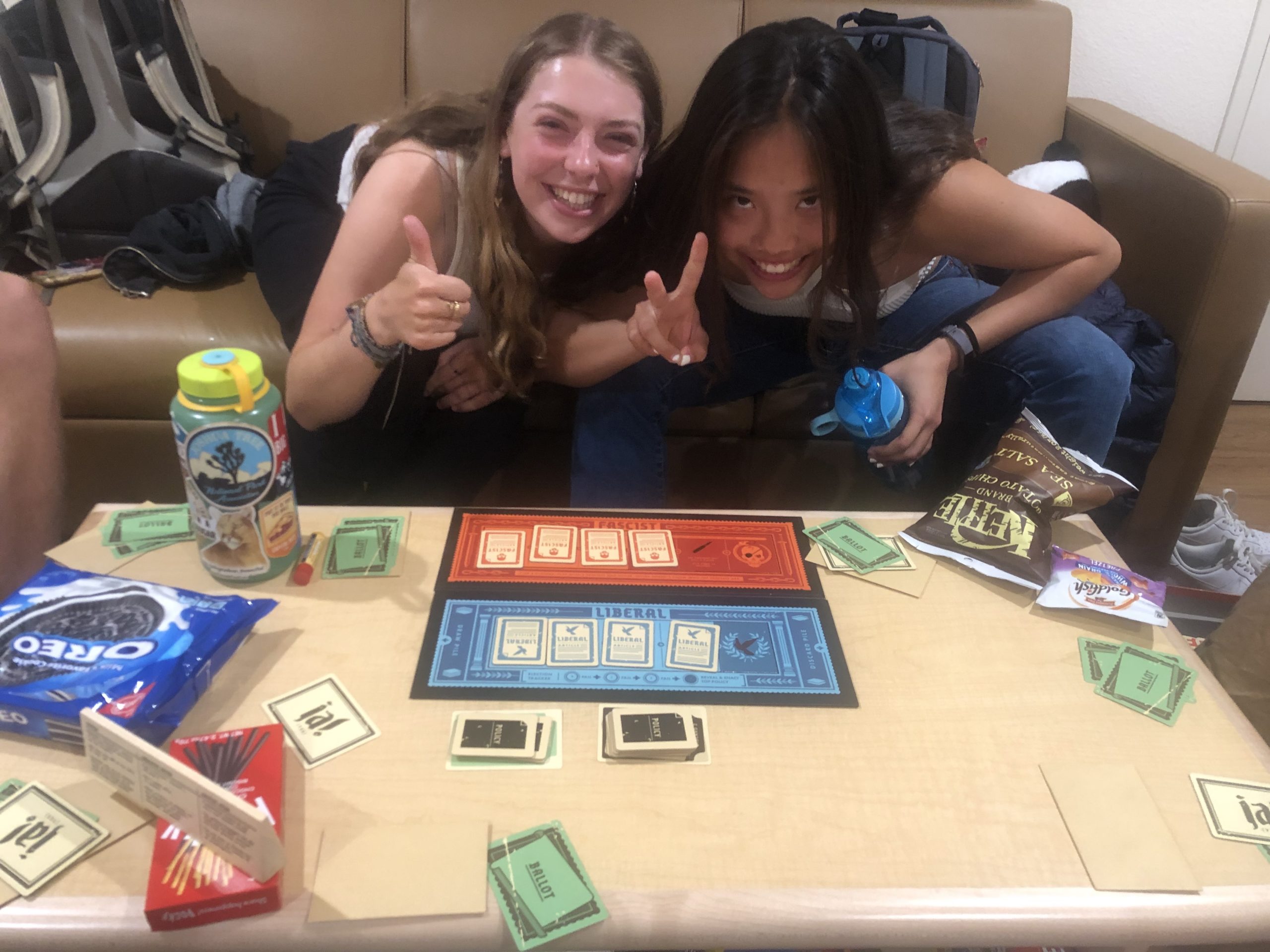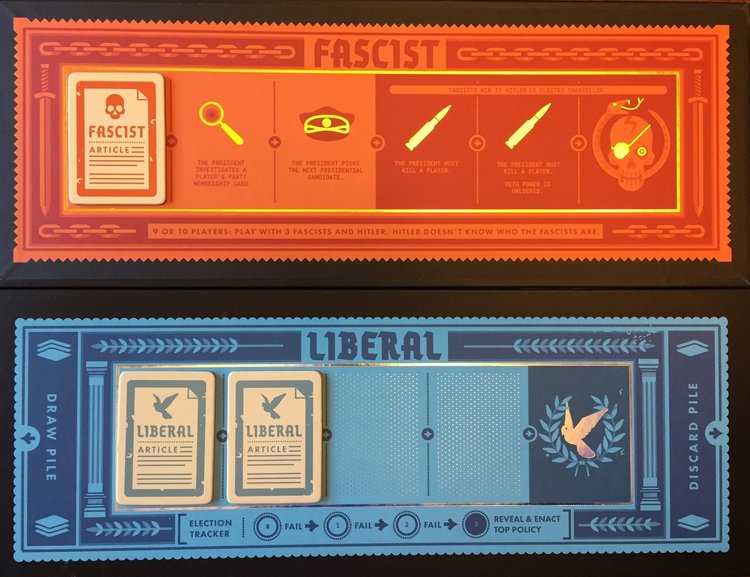
For this assignment, I played Secret Hitler with 6 Stanford friends:

Secret Hitler is a hidden identity social deduction party game developed by Goat, Wolf, & Cabbage LLC and manufactured by Breaking Games. The game targets people who like deductive and social games where the objective is to trick others and I think it’s especially fun to play with a group of close friends.
Players:
In terms of players, the game is designed for 5-10 players who are split into two teams: Liberals and Fascists. One player, a fascist, is assigned to be the “Secret Hitler.” The game is either unilateral or team competition, depending on how many liberals and fascists there are.
Objectives and Outcomes:
Secret Hitler falls under the “outwit” objective category, and the specific mission of each player depends on what team they are on. The Liberal team’s objective is to stop the Fascist regime by finding the Secret Hitler. The objective of the Fascist Team is to defeat the Liberal players by supporting and electing Secret Hitler. Players have to be smart about how they interact with others and try to uncover secret identities without revealing too much about themselves. In the end, either the Liberals or the Fascists win, and so Secret Hitler is a Zero-sum game. The type of fun in this game is Fellowship as it is a game with a big social component. Players have to talk amongst themselves constantly to find out who the Fascists are.
Procedures and Rules:
The game is centered around the passing of fascist and liberal policies. Starting from any player and in clockwise rotations, players take turns playing the role of the president each round. They have to nominate another player as a chancellor. All players then choose to vote “Ja!” (yes) or “Nein!” (no) to approve or dismiss the nominated “team”. If the majority votes “Ja!”, then the team passes and the president chooses two out of three random policy cards to hand over to the chancellor. The chancellor must then pick one of the remaining two policy cards to legislate. One must always be careful with which card they pick as others will be watching. Any fascist policy played will be seen as suspicious by the Liberal Team. When certain policies are passed, the President at the time can enact special powers such as being able to check someone else’s membership, assassinate a player, or choose who the President is for the next round.

Board with policies enacted and team “powers”
The game can end in one of three ways. 1) Six fascist policies are enacted (Fascist win) or 5 liberal policies are played (Liberals win). 2) If Hitler is assassinated the Liberals win. 3) Fascists win if Hitler is elected as Chancellor after 3 fascist policies have been enacted.
Comparison:
Secret Hitler is very similar to one of my favorite games: Avalon. One of the biggest differences is the premise of the game. Avalon has a medieval feel to it, while Secret Hitler involves different political parties. The mechanics of the game also differ slightly. For example, in Secret Hitler, the “teams” are always composed of two people, while in Avalon the team can have up to 4 people. Another big difference is how “missions” are passed or failed. In Avalon, each player has the opportunity to pass or fail a mission, while in Secret Hitler, it depends on the three initial cards that are picked by the President. This introduces a bit of randomness to the game that makes Secret Hitler more of a lying and bluffing game, while Avalon in my opinion requires more deductive skills. Both games are very fun in my opinion and feel very different (in part due to the premise). Having both is definitely better than just one as sometimes the rounds can become a bit repetitive and switching up can make it more entertaining.
Playing:
We first played 4 rounds with seven players and 3 rounds with six players. Both versions felt very different as they had slight changes in rules (for example there was one less fascist when playing with six people)
In both cases, the game was extremely fun mostly due to the intensity and unpredictability. At all times we had to be very focused on how people reacted to their cards to see if they were lying or not. What surprised me about the game was how there can be completely unexpected outcomes. For example in one round, we all had suspicions of one person and completely outed them as a fascist, but they ended up being good. While we lost (as Liberals), I consider this a success as it shows how much of a deceptive game it really is. The game definitely fulfills the goals of the “fellowship” type of fun, as I felt that I was constantly interacting with other players and although we were playing a game, there was a huge social component.
The biggest difference when playing with six players was that the Fascist team had only two members instead of three. I felt that this made the game much easier for the Liberals. We played two rounds with this version, and both were easy wins for the Liberals. At first, we thought it was just luck and that they drew good cards. But after talking with my friends about it for a bit, we realized that the game was no longer balanced, and became boring to play. Anyone who tried to speak up a bit (Fascists) was almost easily outed because Liberals had no need to be vocal or start questioning other players. In order to test this assumption, for the last round we played, I decided to make the game a bit more “chaotic”. I was very vocal and tried to analyze everyone’s behavior, in hopes of confusing both teams. For this round, I was a fascist and so it really helped our team. Although we ended up losing, it felt much more fun than the first few rounds we played with six players. This was because more players started speaking up and trying to deduce who was bad.
Improvements:
One of the biggest issues with Secret Hitler, in my opinion, is that when there are only 6 players, the game becomes much easier for the Liberals as there are only two fascists. Adding another fascist would make the game too uneven, so a change I would make is to add a few more power to the Fascists Board when there are less than 7 players. Another option would be changing the current power (seeing the top three cards in the deck) as this doesn’t really give an advantage to the Fascists. I think I would definitely have to playtest this version as it might make the Fascist team too overpowered.


